火星 ALPO-Japan Latest

Mars Image 2020/09/14(UT)
荒川 毅,森田光治,井上 修,大杉忠夫,薄出敏彦,中野雄吉,鶴海敏久,熊森照明,山口貴弘,安達 誠,柚木健吉,伊藤了史,尾崎公一
Moises Portillo Leon,Clyde Foster,Paul G. Abel,Randy Tatum,Jorge Rallo,Pericles Enache,Walter Martins,Chris Nuttall,Anthony Wesley,Stanislas Maksymowicz,Simon Kidd,Efrain Morales Rivera,Siegfried Gonzi,Kev Wildgoose,Sonka Adrian,John Sussenbach,Willian Souza,Jean-Luc Dauvergne,Johan Warell,Christian Pankratz,Richard Bosman,Marin Prodan,Vlamir da Silva Junior
M.P.Leon,C.Foster,P.Abel,R.Tatum,Jorge.R,T.Arakawa,P.Enache,W.Martins,C.Nuttall,M.Morita,O.Inoue,Anthony.W,T.Ohsugi,T.Usude,S.Maksymowicz,Y.Nakano,T.Tsurumi,T.Kumamori,T.Yamaguchi,S.Kidd,E.Morales,S.Gonzi,K.Wildgoose,M.Adachi,S.Adrian,J.Sussenbach,W.Souza,JL Dauvergne,K.Yunoki,S.Ito,J.Warell,K.Ozaki,C.Pankratz,R.Bosman,M.Prodan,V.da Silva Jr.
解説(安達)/ Comment by Makoto Adachi
今日も、ほぼ火星面全体の情報が得られた。Clyde Foster氏のカラー画像は、SPCの北側に黄色くダスティーな部分を記録している。
前日に荒川氏がArgyreの西に記録したものがこれである。このダストは東西に90°程度広がっている。井上氏の画像は、Noachis
(335W~10W,-25~-30)付近のリムを記録している。黄色は淡くなっており、この地域のダストは減ってきている様子が分かる。
Stanislas Maksymowicz氏はArabia Terra付近がダスティーになっている様子を記録している。カラー画像ではわかりにくいが、
眼視観測だと、見えてくる特徴である。
柚木氏は350-440nmの光で観測している。この波長だと地表が記録されない。580-700nmの画像、中央上がHellasになる。
左にMare Tyrrehenumが黒く見えているが、これは地表の模様が見えているのではなく、大気に晴れ間ができているものである。
カラー画像だと模様の黒く見える部分に一致する。Mare Serpentis (325W,-25)付近の2つの暗い斑点も、同じであるが、いずれも
高地に相当する。このように地表の写らない波長の画像は重要である。
Syrtis Major (293W,+0~20)の東隣のLibya (275W,+3)からIshidis (270W,+23)付近は、ターミネーターに近づくと、白雲が目立つ
ようになる。荒川,井上,安達,柚木,伊藤が、その姿を記録している。井上氏は観測時間が長いので、変化の様子がよくわかる。筆者は、
ターミネーターに差し掛かると、雲はSyrtisの東半分にかぶさっている様子を観測した。その際、Syrtisはかなり青っぽくなる様子が見られる。
Even today,information on almost the entire surface of Mars was obtained. Clyde Foster's color image records a yellow dusty area
on the north side of the SPC. This is what Arakawa recorded to the west of Argyre the day before. This dust spreads about 90 ° from
east to west. Mr. Inoue's image records the rim near Noachis (335W ~ 10W,-25 ~ -30). The yellow color is fading,indicating that
the dust in this area is decreasing. Stanislas Maksymowicz has recorded a dusty area near Arabia Terra. It is difficult to understand
in a color image,but it is a feature that can be seen by visual observation.
Yunoki is observing with light of 350-440 nm. The surface of the earth is not recorded at this wavelength. 580-700nm image,
Hellas on the center. Mare Tyrrehenum appears black on the left,but this is not a pattern on the surface of the earth,but
a clear atmosphere. If it is a color image,it matches the black part of the pattern. The two dark spots near Mare Serpentis (325W,-25)
are similar,but both correspond to the highlands. Images with wavelengths that do not show the surface of the earth are important.
From Libya (275W,+ 3) to Ishidis (270W,+ 23) to the east of Syrtis Major (293W,+ 0 ~ 20),white clouds become noticeable as
you approach the terminator. Arakawa,Inoue,Adachi,Yuki,and Ito have recorded their appearance. Inoue has a long observation time,
so he can understand the change. As I approached Terminator,I observed clouds over the eastern half of Syrtis. At that time,Syrtis
seems to be quite bluish.
(by 31 observations; reported by Makoto Adachi)
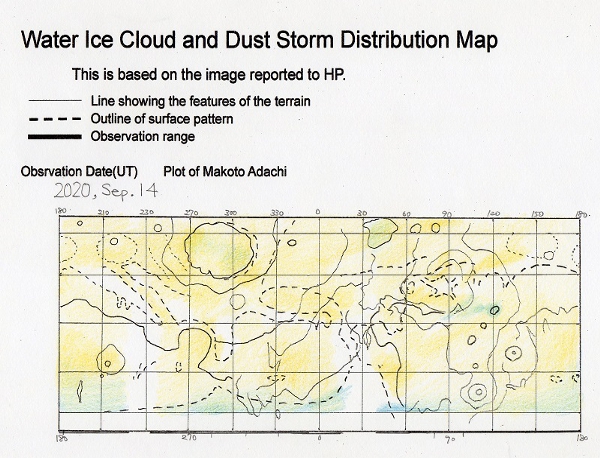 -------------------------------------------------------------------------------------
-------------------------------------------------------------------------------------
 [Moises Portillo Leon,Andujar:Spain)]
[Moises Portillo Leon,Andujar:Spain)]
My conscience finally got the better of me in the early hours of this morning,
with Mars having suffered some neglect from my side with so much attention on the developments on Jupiter.
The IR was the best,but conditions not great for the RGB. If nothing else,a nice low res view of Solis Lacus.
 [Clyde Foster:Centurion,South Africa]
[Clyde Foster:Centurion,South Africa]
I have been experimenting with new colouring techniques and I think this new scheme gives a more realistic impression.
Seeing was largely good and I used a power of x300 throughout:
- SPC somewhat irregular.
- Both Dia and Argyre II brighter regions.
- This is probably my finest view of Solis Lacus- Thaumasia and other regions within fairly well defined.
- Ophir region quite bright- a lighter streak in Candor quite noticeable,and Ganges well defined dark streak
- Nilokeras present and extending into the dark streak from Ganges?
- By the time of drawing 2,Sirenum is starting to appear with Phaethontis and Thyle I present.
- Following limb quite bright,northern limb bright and bluish,
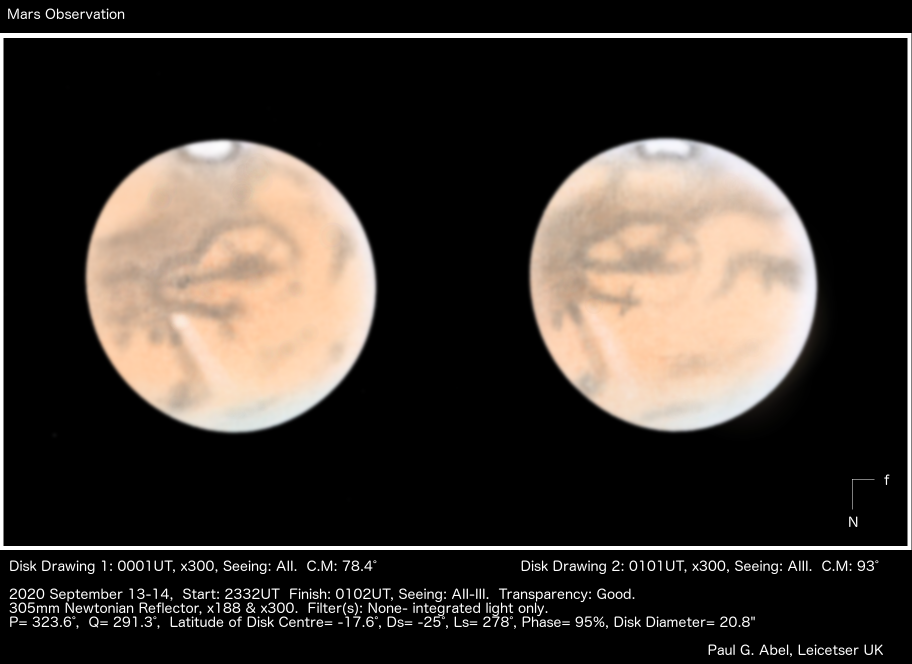 Seeing was AII-III with hazy conditions,but I had some excellent views of the Martian surface at a power of x300 on my 12" Reflector.
The main points of interest were as follows:
- South Polar Cap somewhat irregular but easy to see.
- Argyle I and Argyre II fairly well defined as was Campi Phlegrael.
- Solis Lacus again well presented,Thaumasia and Felix well defined.
- A lot of interesting detail in Mare Erythraeum.
- Ophir was bright a bright streak present in Candor next to Ganges which was appeared as a darker streak.
- Niliacus Lacus present on the prec. limb? Nilokeras also seen.
Seeing was AII-III with hazy conditions,but I had some excellent views of the Martian surface at a power of x300 on my 12" Reflector.
The main points of interest were as follows:
- South Polar Cap somewhat irregular but easy to see.
- Argyle I and Argyre II fairly well defined as was Campi Phlegrael.
- Solis Lacus again well presented,Thaumasia and Felix well defined.
- A lot of interesting detail in Mare Erythraeum.
- Ophir was bright a bright streak present in Candor next to Ganges which was appeared as a darker streak.
- Niliacus Lacus present on the prec. limb? Nilokeras also seen.
 [Paul G. Abel:Leicester:United Kingdom]
[Paul G. Abel:Leicester:United Kingdom]

 [ Randy Tatum,Richmond,VA U.S.A]
[ Randy Tatum,Richmond,VA U.S.A]
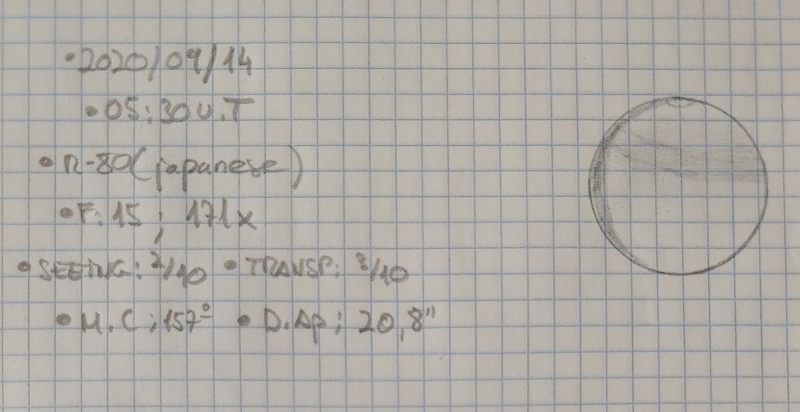 [Jorge Rallo : Madrid,Spain]
[Jorge Rallo : Madrid,Spain]
久しぶりに良く晴れてくれましたが、時間が経つほどシーイングが悪化したため、南中を待たずに途中断念しました。
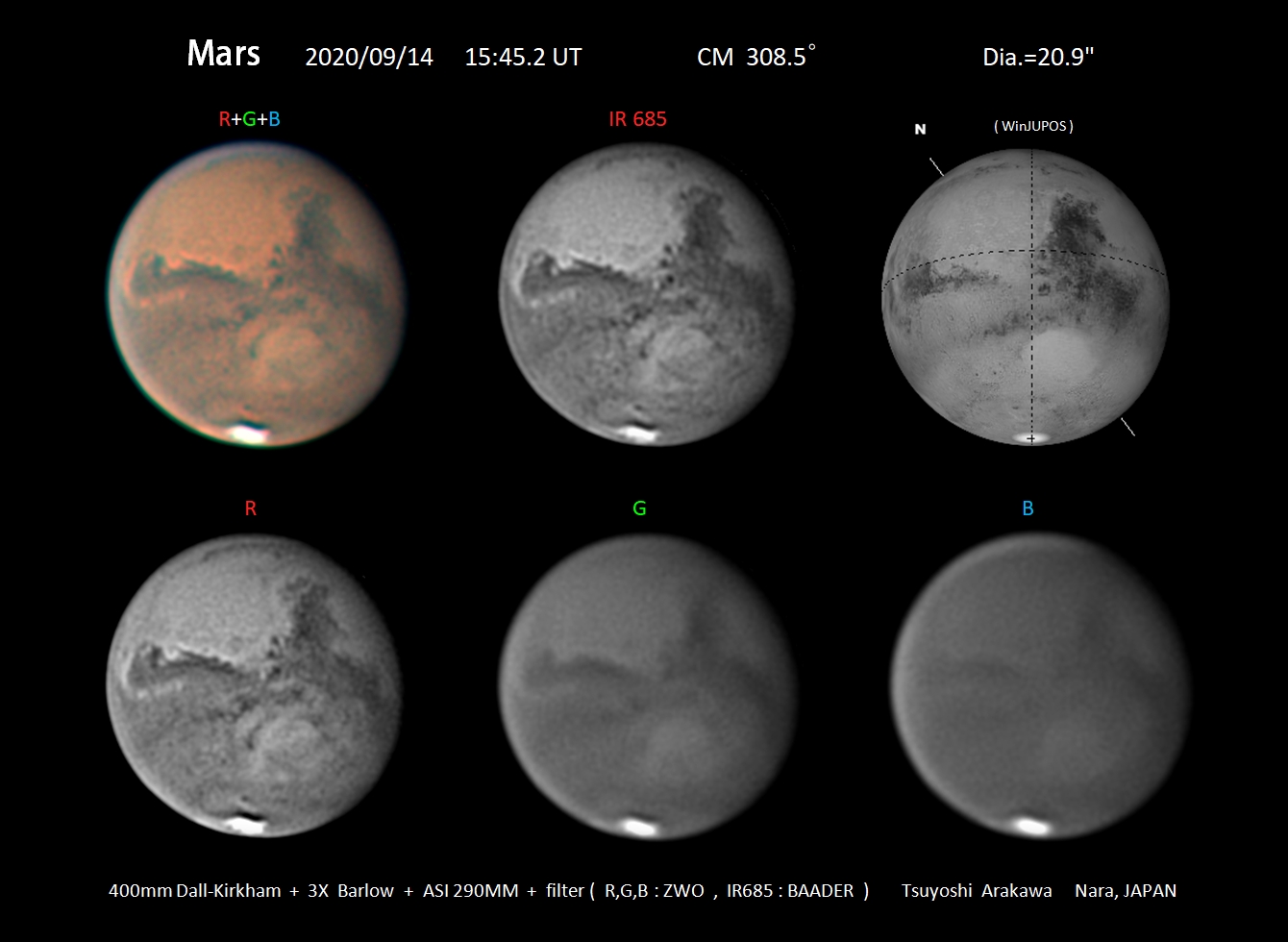 ≪奈良県奈良市 荒川 毅≫[Tsuyoshi Arakawa:Nara Japan]
≪奈良県奈良市 荒川 毅≫[Tsuyoshi Arakawa:Nara Japan]
I started the observation run with IR 642 BP because the sky conditions are no good due to smoke from Pantanal fires in the high atmosphere over Sao Paulo.
Then,I tried some RGB sets and,lucky enough,one set was of some reasonable quality.
Pantanal is a natural region that has the world's largest tropical wetland but facing severe drought this year.
The problem is that Pantanal is 1.700 km distant from Sao Paulo city and it gives us an idea about the dimension of what is going on there.
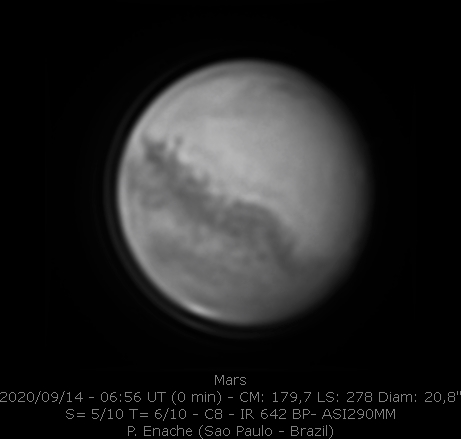
 [Pericles Enache,Sao Paulo,Brazil]
[Pericles Enache,Sao Paulo,Brazil]
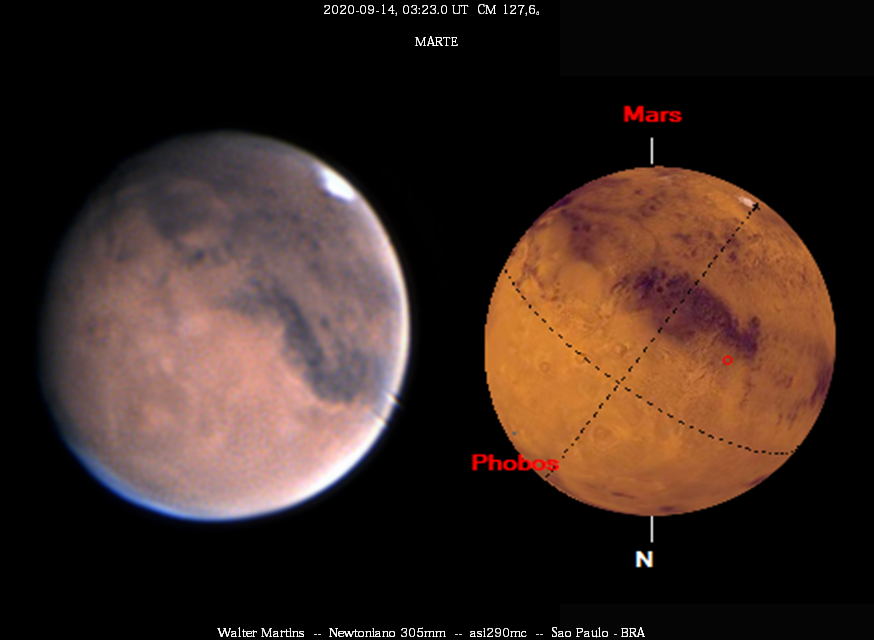 [Walter Martins : SAO PAULO BRAZIL]
[Walter Martins : SAO PAULO BRAZIL]
Seeing was Ant II,with the odd second here and there approaching Ant I.
Solis Lacus was well seen,with plenty of detail around the dark eye.
Just a hint of brightness North of Agathodaemon (in the area of Valles Marineris),
it hasn't come out very obviously on the drawing,but looked like faint cloud.
Daedalia (between Solis Lacus and Mare Sirenum) looks dark.
The NPH was very bright bluish white,and I thought I saw a gap at its southern edge with another streak of hood adjacent to that.
Morning limb brightening extends up away from the NPH,but it not very dense.
The somewhat yellower SPC is looking tatty now,with three distinct outcrops protruding from its boundary.
On the morning limb Electris and Thylle 1 are quite bright,the latter also bright in the green filter so possibly a little dusty there.
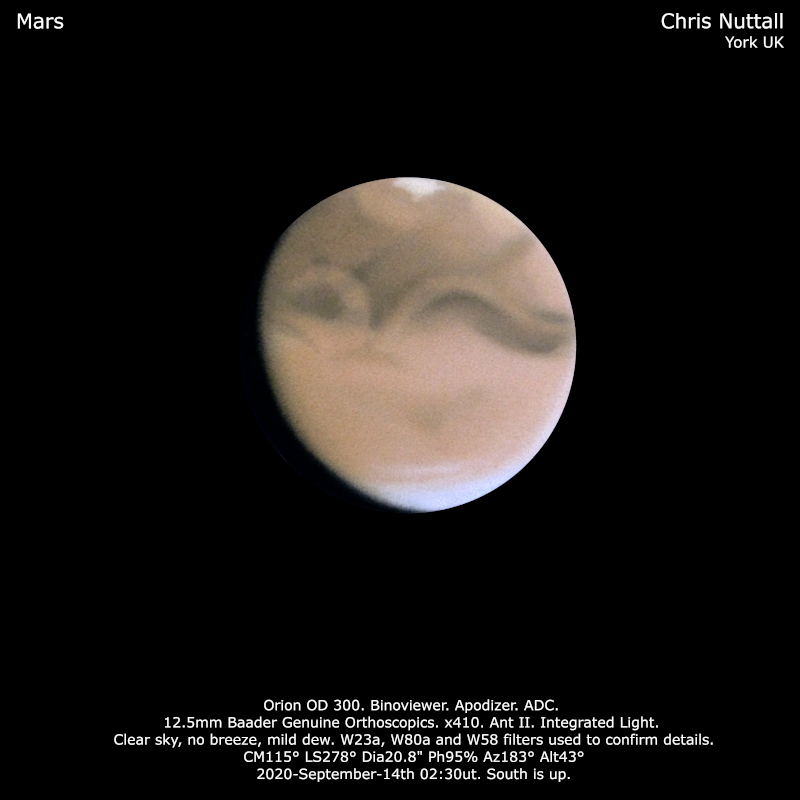 [Chris Nuttall : York,UK]
[Chris Nuttall : York,UK]
秋のさわやかな透明度の良い空気の中'の撮影だったが、シーイングがよくなかった。
winJUPOSが使えるようになったので中央経度、視直径を入れることができた。
 ≪滋賀県守山市 森田光治≫[Mitsuji Morita:Siga Japan]
≪滋賀県守山市 森田光治≫[Mitsuji Morita:Siga Japan]
良く晴れ、シーイングは14時台は今一つでしたが、15時台にはかなり良くなりました。
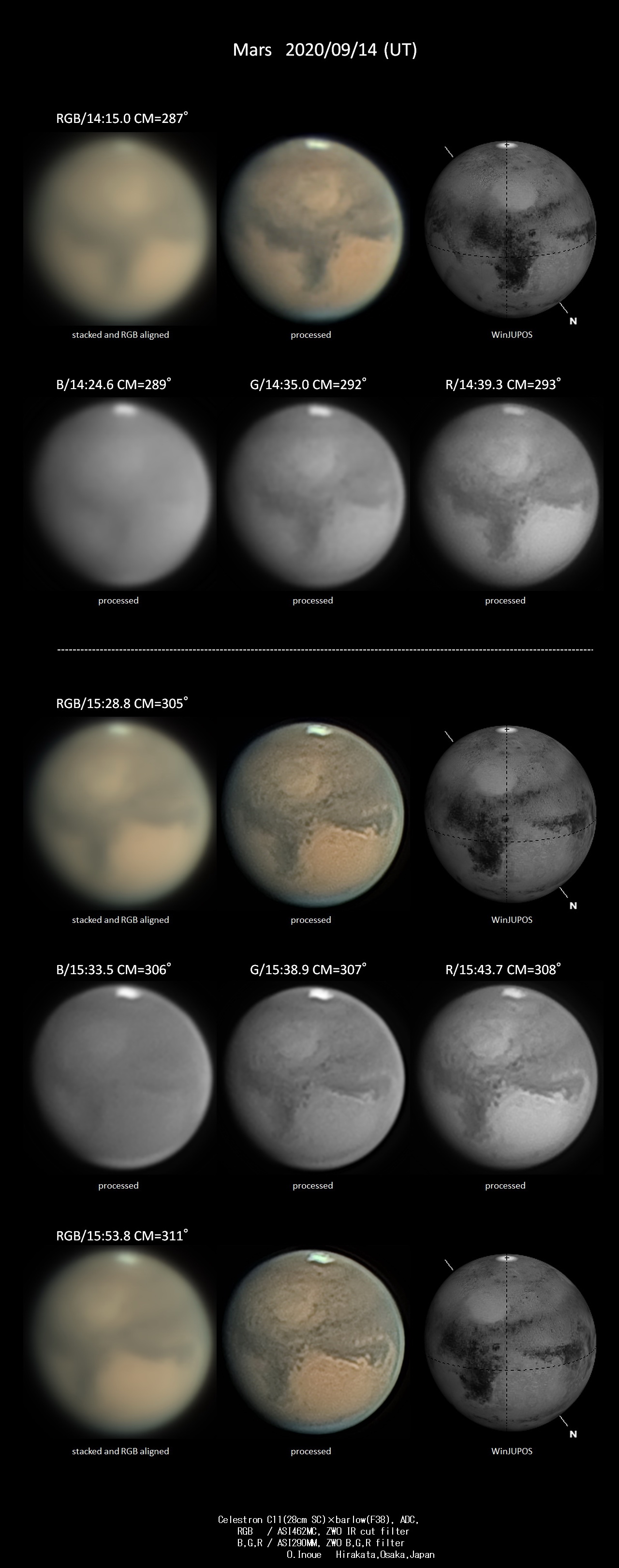 ≪大阪府 枚方市 井上 修≫[Osamu Inoue. Hirakata-shi,Osaka,Japan]
≪大阪府 枚方市 井上 修≫[Osamu Inoue. Hirakata-shi,Osaka,Japan]
Hi all,some good seeing this morning on Mars,here's a true colour RGB image made by combining nearly an hours worth of RGBB data.
The hard part with combining data in WinJupos is to get the template rotation correct,
it's quite frustrating trying to do this on surface features so in the end I gave up and used the moons Attached for your amusement is a 60-second stack of overexposed IR650 longpass showing Phobos and Deimos (indicated also by WJ).
The other constellations of marks are all from hot pixels,you can see that they all have the same pattern from the alignment and stacking,whereas Phobos and Deimos are single images.
Note Deimos also has a bright pixel added by WJ as part of the measurement template.
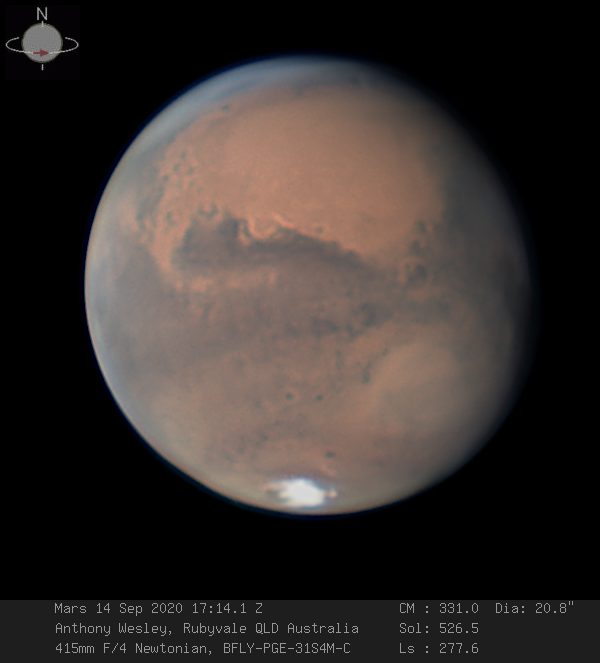
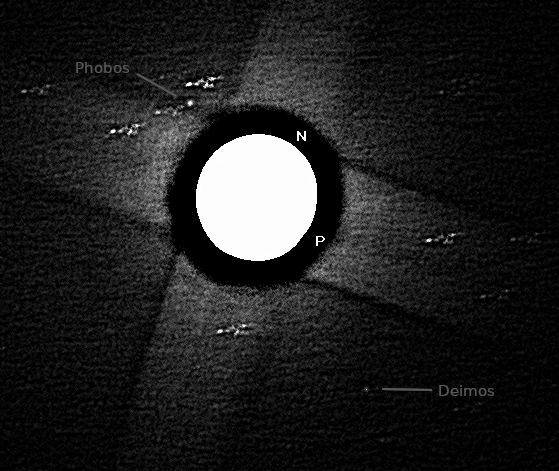 [Anthony Wesley,Murrumbateman Australia]
≪アンソニ オーストラリア≫
[Anthony Wesley,Murrumbateman Australia]
≪アンソニ オーストラリア≫
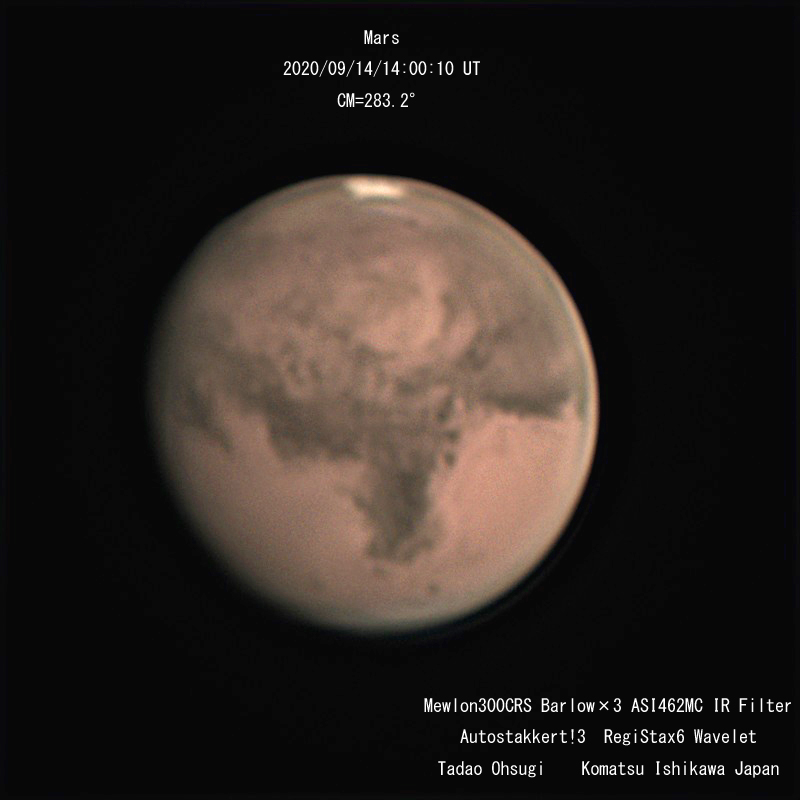
 ≪石川県小松市 大杉忠夫≫[Tadao Ohsugi:Komatsu city Ishikawa pre,Japan]
≪石川県小松市 大杉忠夫≫[Tadao Ohsugi:Komatsu city Ishikawa pre,Japan]
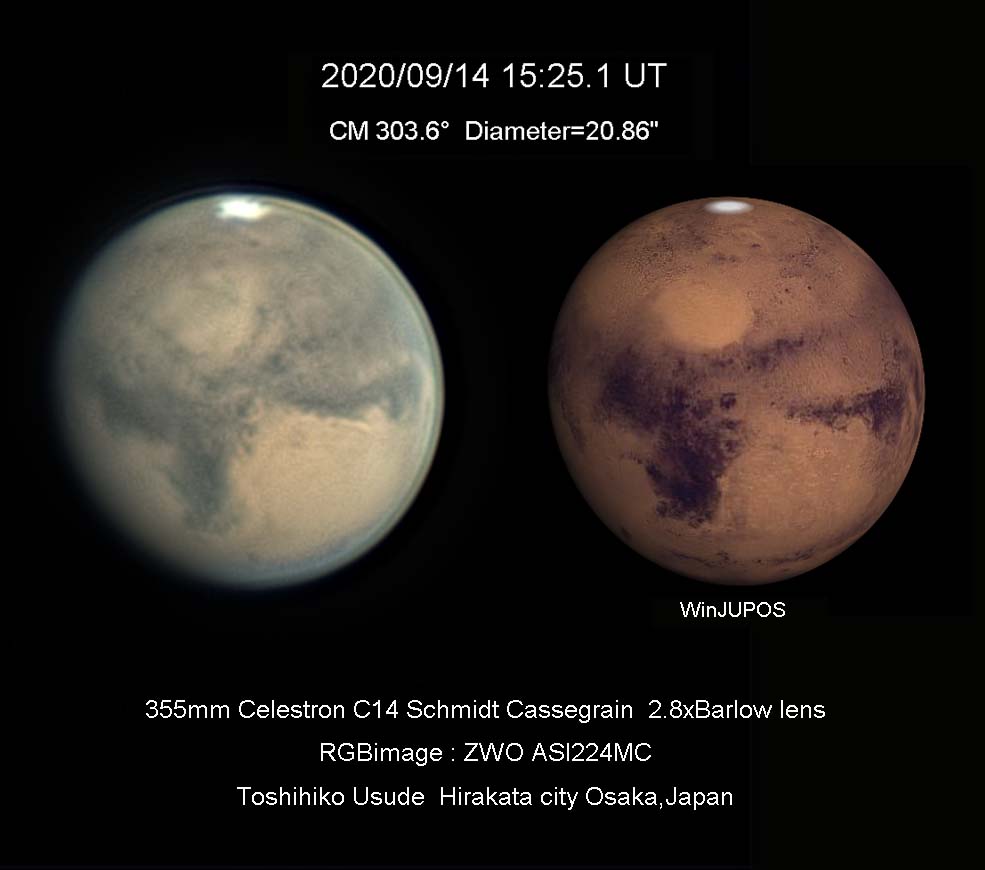 ≪ 大阪府 枚方市 薄出敏彦≫[Toshihiko-Usude: Ohsaka Japan]
≪ 大阪府 枚方市 薄出敏彦≫[Toshihiko-Usude: Ohsaka Japan]
Here is a report of mars performed last 14th with the 127mm apo under average images.
Contrasts given on sketch are considerably enhanced,
the colored sketch gives an overall status of what is observed at the eyepiece using 167x and more magnification.
The scan process makes the color a little more orange,
in fact this is more milky yellow with faint contrast levels.
A yellow veil is seen on Moab-Arabia area.
With the violet filter,Mare Erytraeum is still accessible,faint,
the planet face is shared by clearties as mentionned,bright hazze on the northern area.
 [Stanislas Maksymowicz Ecquevilly,France]
[Stanislas Maksymowicz Ecquevilly,France]
薄雲があり透明度はイマイチですがシーイングは割と良さそうです。
ヘッラスが午前に明るく輝く。北部と北西部は相変わらず明るく白雲がありそうです。大シルチスも小シルチスも濃く見える。
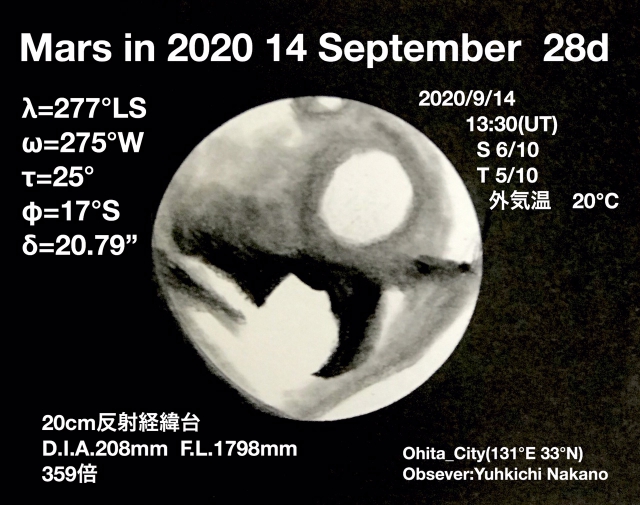 ≪大分県大分市 中野雄吉≫
[Yuukichi Nakano : Ohita-Ohoita prefecture Japan]
≪大分県大分市 中野雄吉≫
[Yuukichi Nakano : Ohita-Ohoita prefecture Japan]
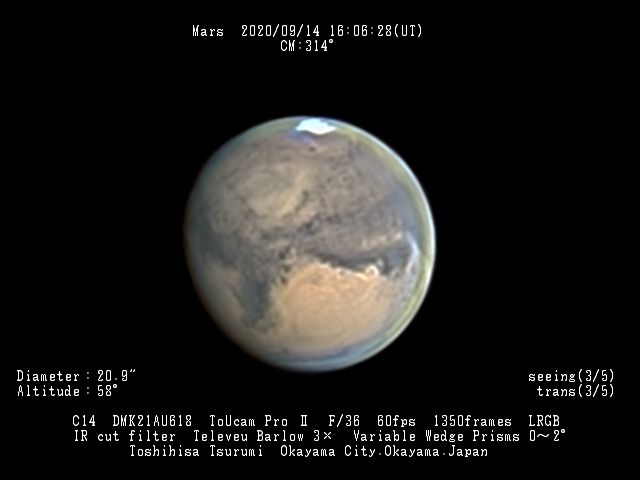 ≪岡山県岡山市 鶴海敏久≫[Toshihisa Tsurumi:Okayama-City Okayama-Prefecture Japan]
≪岡山県岡山市 鶴海敏久≫[Toshihisa Tsurumi:Okayama-City Okayama-Prefecture Japan]
久しぶりの快晴になり、シーイングもまずまず良好でした。
 ≪大阪府堺市 熊森照明≫[Teruaki Kumamori:Ohsaka Japan]
≪大阪府堺市 熊森照明≫[Teruaki Kumamori:Ohsaka Japan]
地表付近は少し風がありましたが、まずまずのシーイングでした。
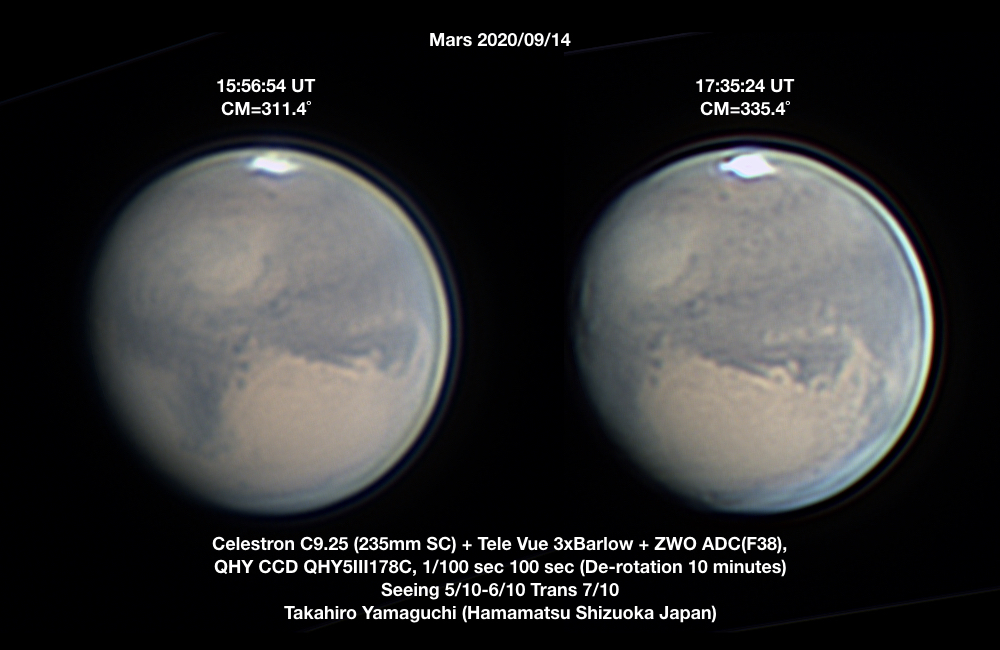 ≪静岡県浜松市 山口貴弘≫[Takahiro Yamaguchi : Hamamatsu-City Shizuoka-Prefecture Japan]
≪静岡県浜松市 山口貴弘≫[Takahiro Yamaguchi : Hamamatsu-City Shizuoka-Prefecture Japan]
Some good seeing: a cool,misty,very still morning.
There are some whitish patches that might be clouds towards the right of the image.
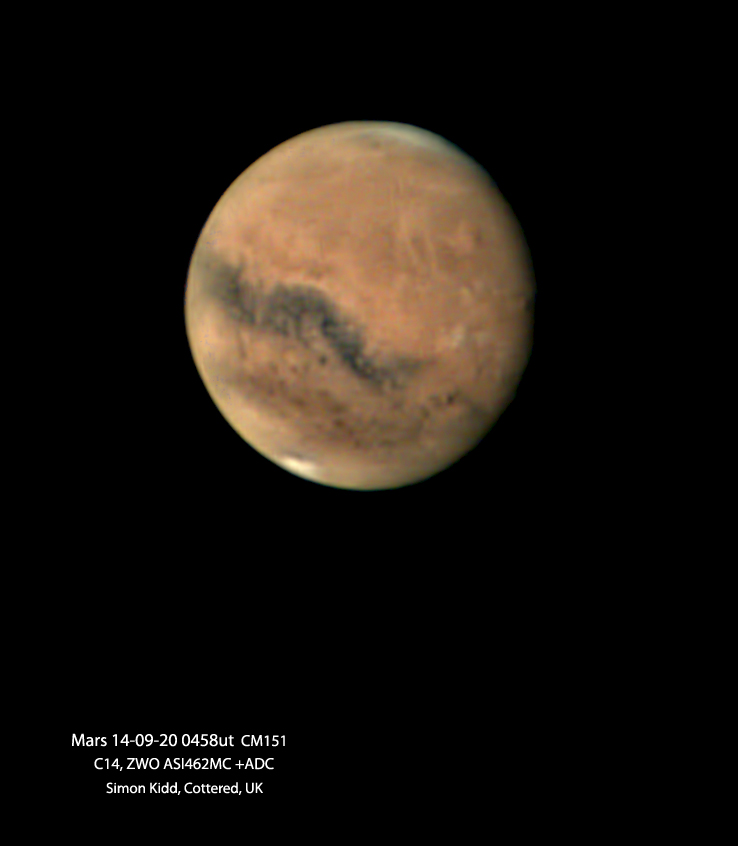 [Simon Kidd: Welwyn Herts,United Kingdom]
[Simon Kidd: Welwyn Herts,United Kingdom]
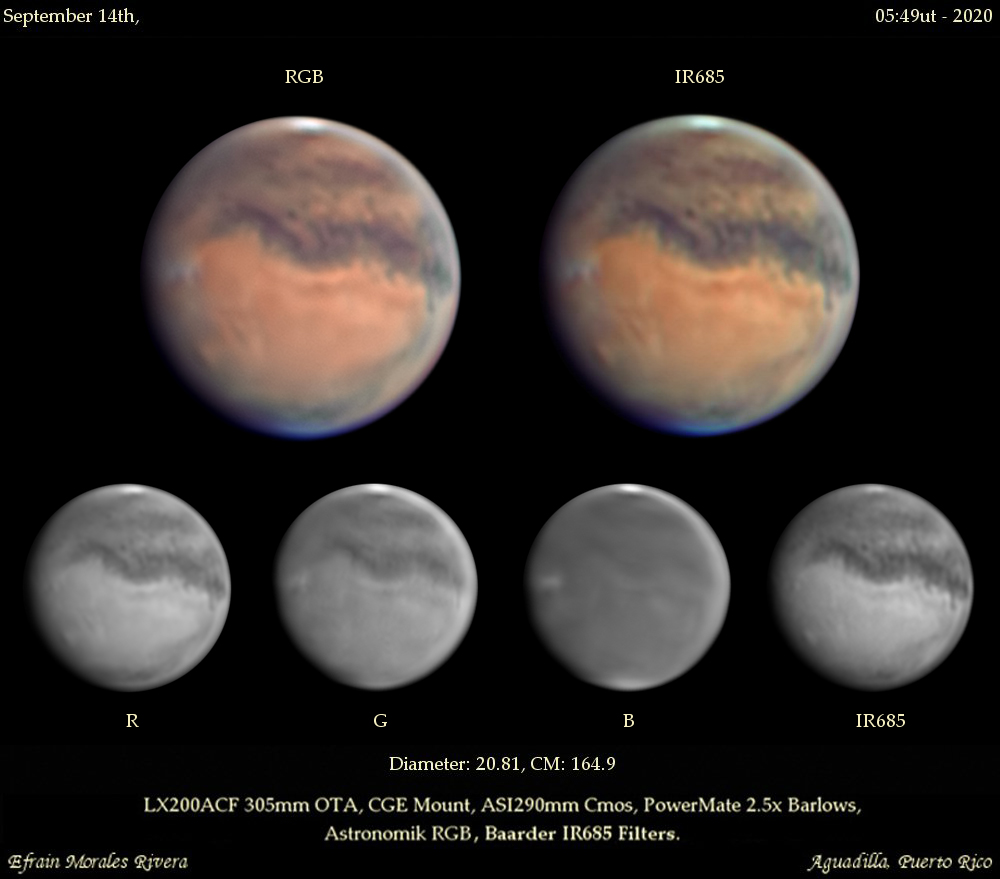 [Efrain Morales Rivera Aguadilla:Puerto Rico]
[Efrain Morales Rivera Aguadilla:Puerto Rico]
 [Siegfried Gonzi : Exeter,United Kingdom]
[Siegfried Gonzi : Exeter,United Kingdom]
Very good seeing here on the night of the 13 ・14th September.
The best conditions I have seen here for Mars in the UK for several years !
The attached was created from 3 images captured during the early hours of the 14th,
de rotated in Winjupos,each the best 4,000 from 24,000 frames.
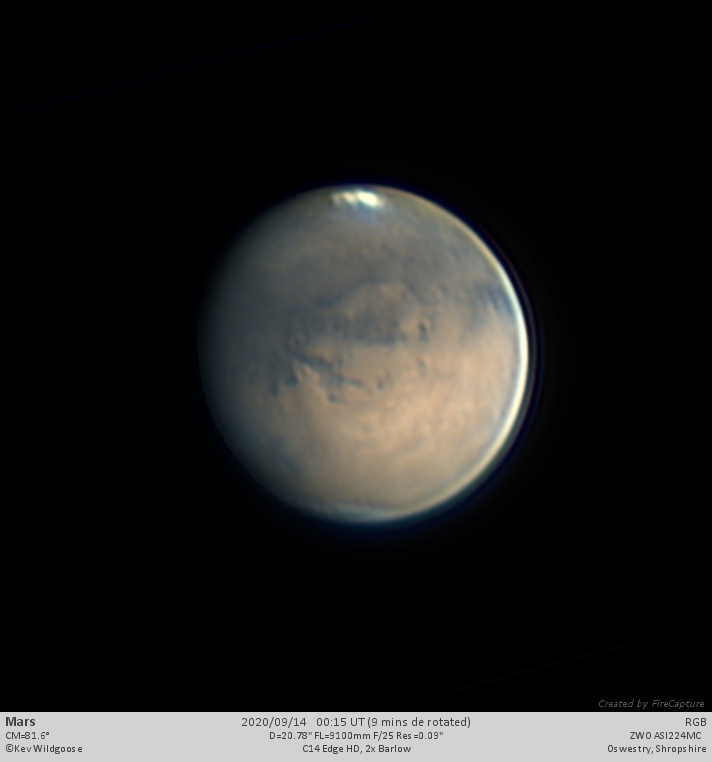 [Kev Wildgoose:Oswestry,UK]
[Kev Wildgoose:Oswestry,UK]
木星と方向が違うだけで、気流がずいぶんちがった。透明度がよく、色がよく見えた。青っぽい模様が印象的だった。


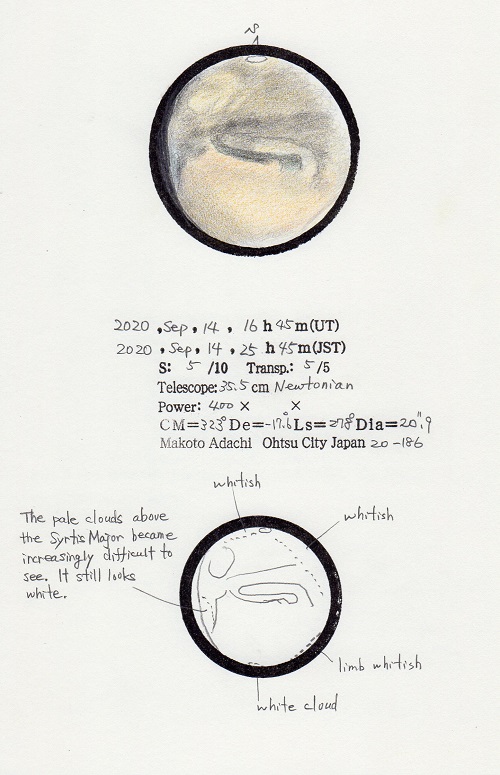 --------------------------------------------------------------
≪滋賀県 大津市 安達 誠≫[Makoto Adachi:Siga Japan]
--------------------------------------------------------------
≪滋賀県 大津市 安達 誠≫[Makoto Adachi:Siga Japan]
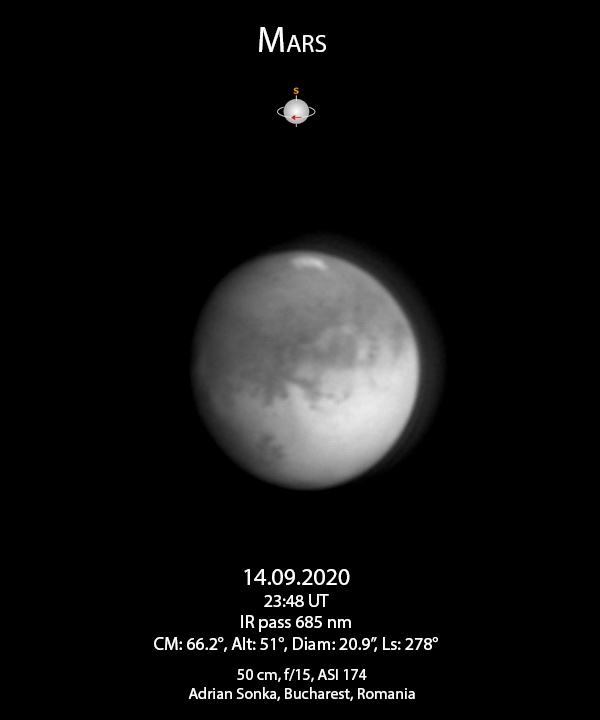 [Sonka Adrian Bruno:Bucharest,Romania]
[Sonka Adrian Bruno:Bucharest,Romania]
 [スセンバッハ:オランダ]
[John Sussenbach:Houten,Netherlands]
[スセンバッハ:オランダ]
[John Sussenbach:Houten,Netherlands]
The animation contains images captured from 01h51 to 02h25TU (2020.09.14)
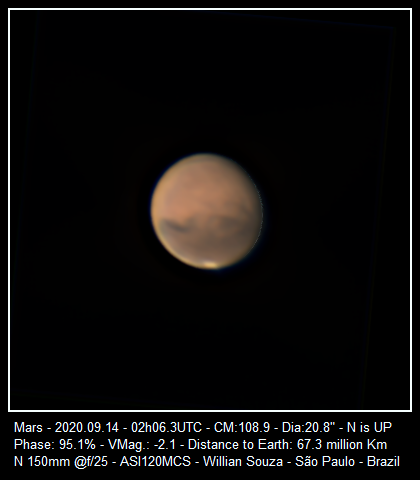
 [Willian Souza : Sao Paulo,Brazil]
[Willian Souza : Sao Paulo,Brazil]
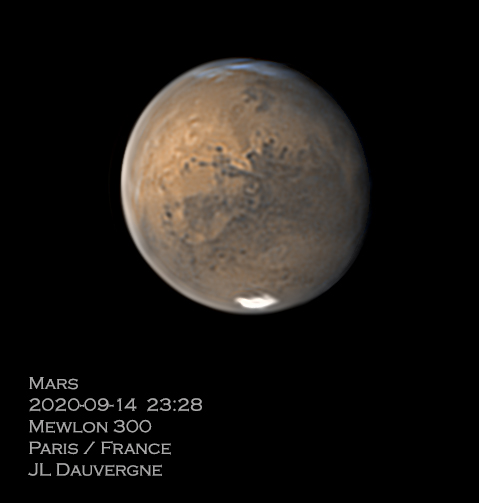 [Jean-Luc Dauvergne:Paris France]
[Jean-Luc Dauvergne:Paris France]
be410で見ると、時間とともにイシダス辺りに夕霧が発生していったことが判る。
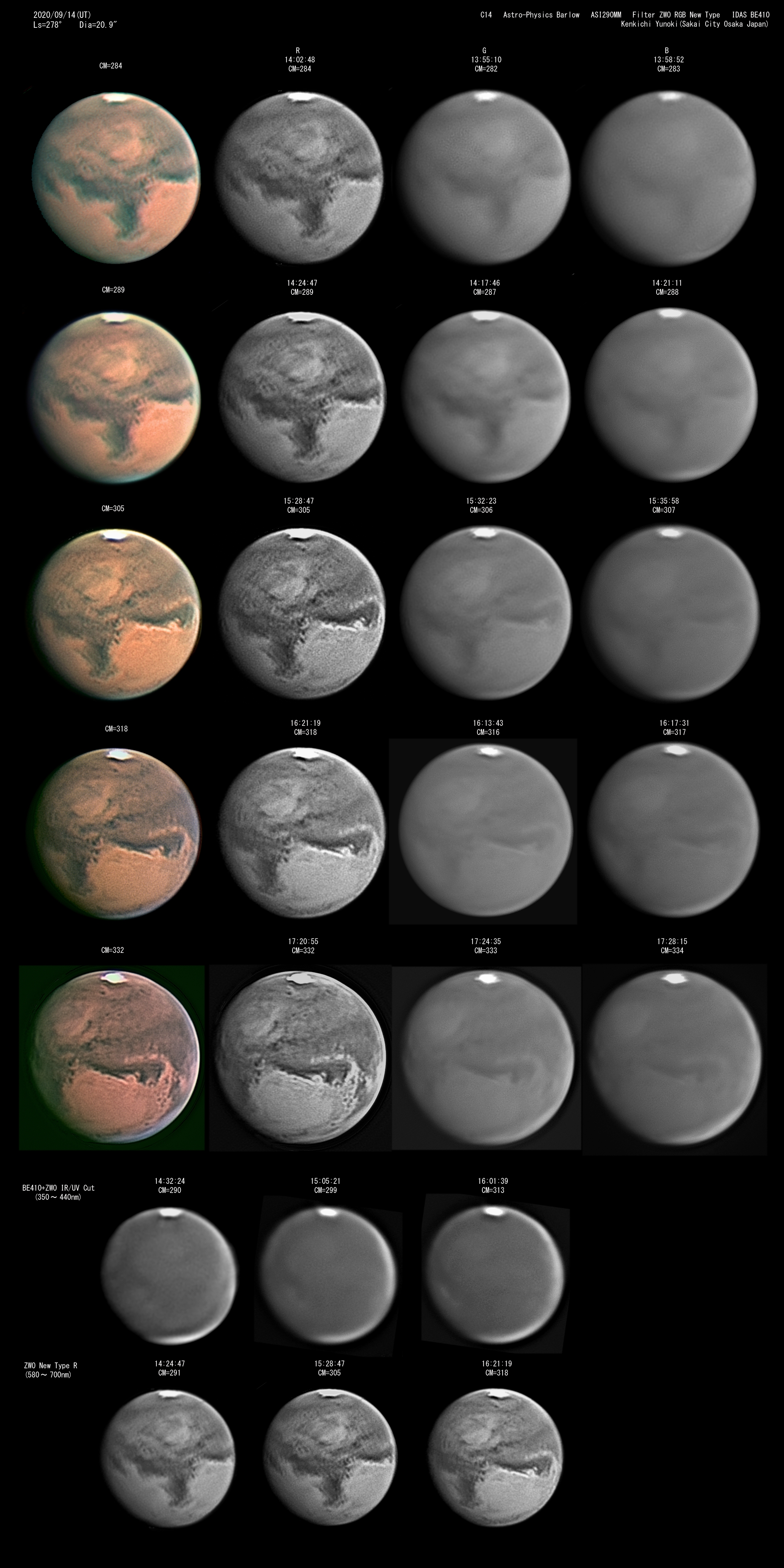 [Kenkichi Yunoki (Sakai City,Japan)]
≪大阪府 堺市 柚木健吉≫
[Kenkichi Yunoki (Sakai City,Japan)]
≪大阪府 堺市 柚木健吉≫
コメント追加(2020/10/10)
少し前からB390フィルターで青波長域の撮像も試行していましたが、ノイズで使えなかったり、処理が上手く出来ず報告は控えておりました。
最近(自己判断ではありますが)やっと見れる感じの処理が出来ましたのでここ一か月位の撮像データを確認した所、
9月14日の火星青色画像は何とかなりましたので画像を差替えます。
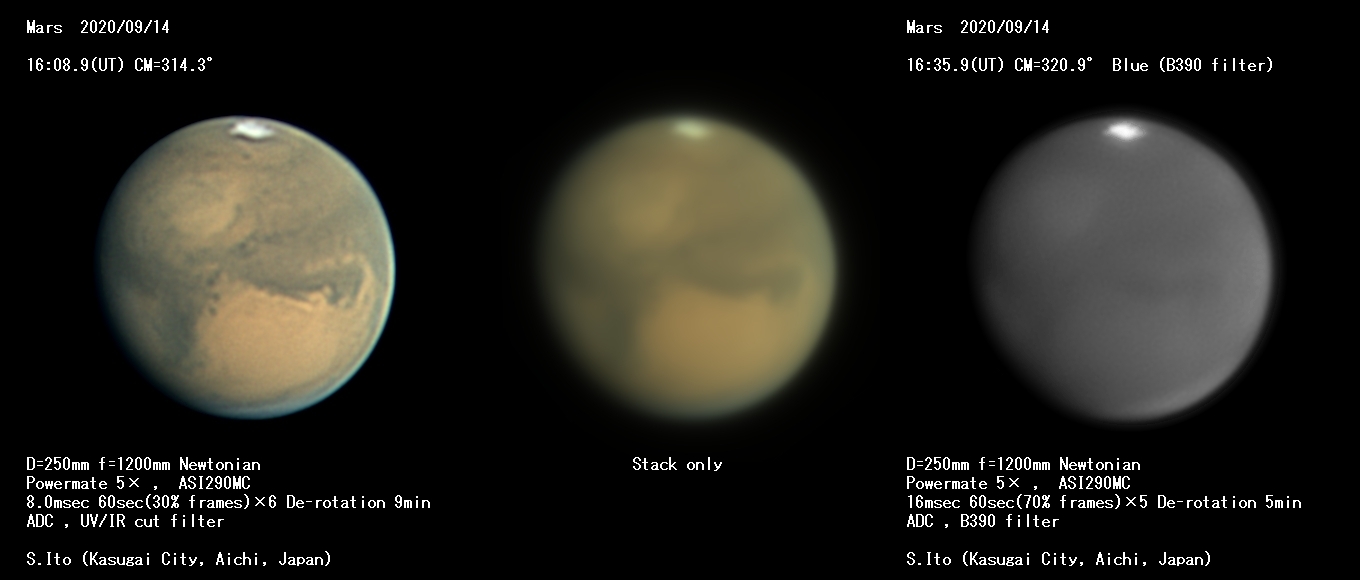 ≪愛知県 春日井市 伊藤了史≫[Satoshi Ito. Kasugai City,Aichi,Japan]
≪愛知県 春日井市 伊藤了史≫[Satoshi Ito. Kasugai City,Aichi,Japan]
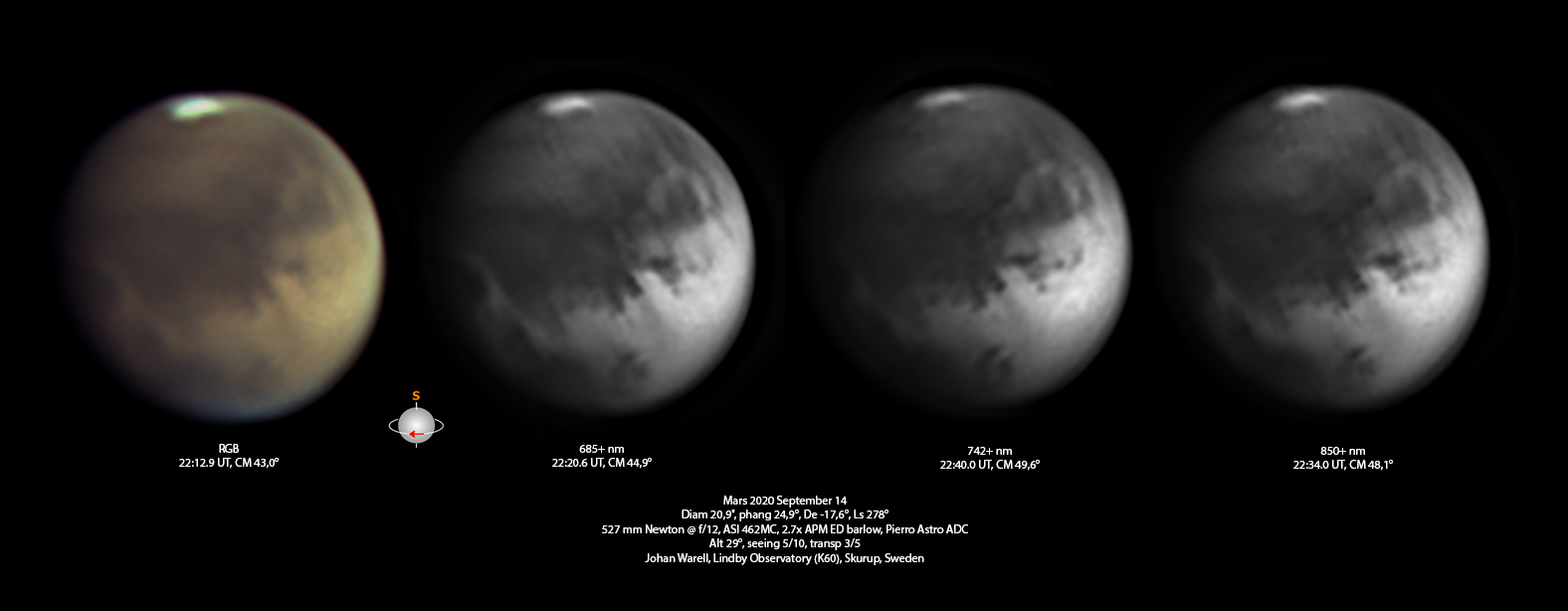 [Johan Warell:Lindby:Sweden]
[Johan Warell:Lindby:Sweden]
子午線湾付近の南北には白雲(朝霧??)のようなものが広範囲に拡がっているようです。上空に強く風が吹いているようで透明度は良好だが seeing があまり良くなく・・・・。
 [Ki.Ozaki,Sobue Inazawa Aichi JAPAN]
≪愛知県稲沢市祖父江町 尾崎公一≫
[Ki.Ozaki,Sobue Inazawa Aichi JAPAN]
≪愛知県稲沢市祖父江町 尾崎公一≫
Seeing 6/10 Trans 6/10
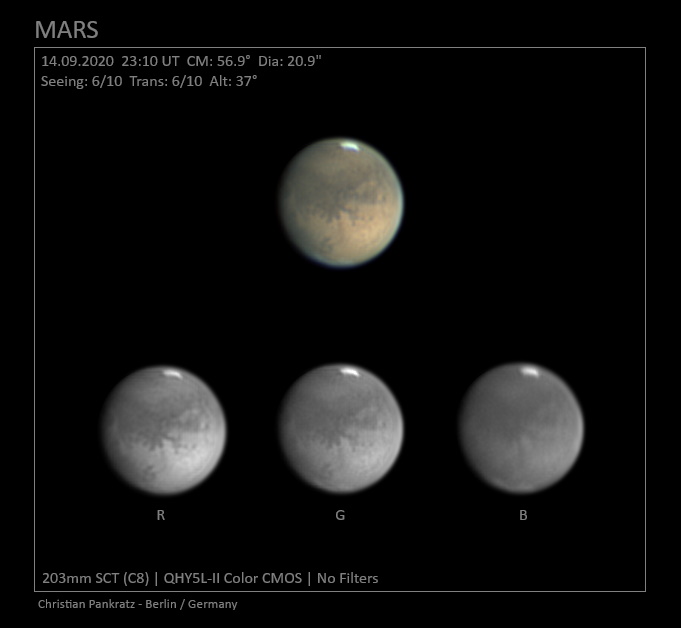 [ Christian Pankratz : Berlin Germany]
[ Christian Pankratz : Berlin Germany]
I have edited this observation somewhat differently from what you may be used to.
This time I chose to do it a little less than usual.
Mars observations are made with RGB filters and are also used in the processing of clean RGB (so no RRGB or LRGB etc.).
I have left the large one exactly how I record it with the C14 at 10 meters focal distance.
When using pure RGB perception,the sharpness may become less,but that doesn't matter this time. No d-rotation done.
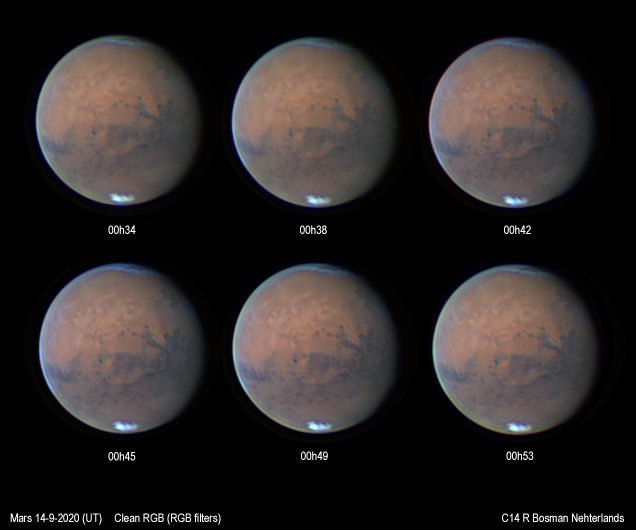 Here then the impression of Mars that morning.
Here then the impression of Mars that morning.
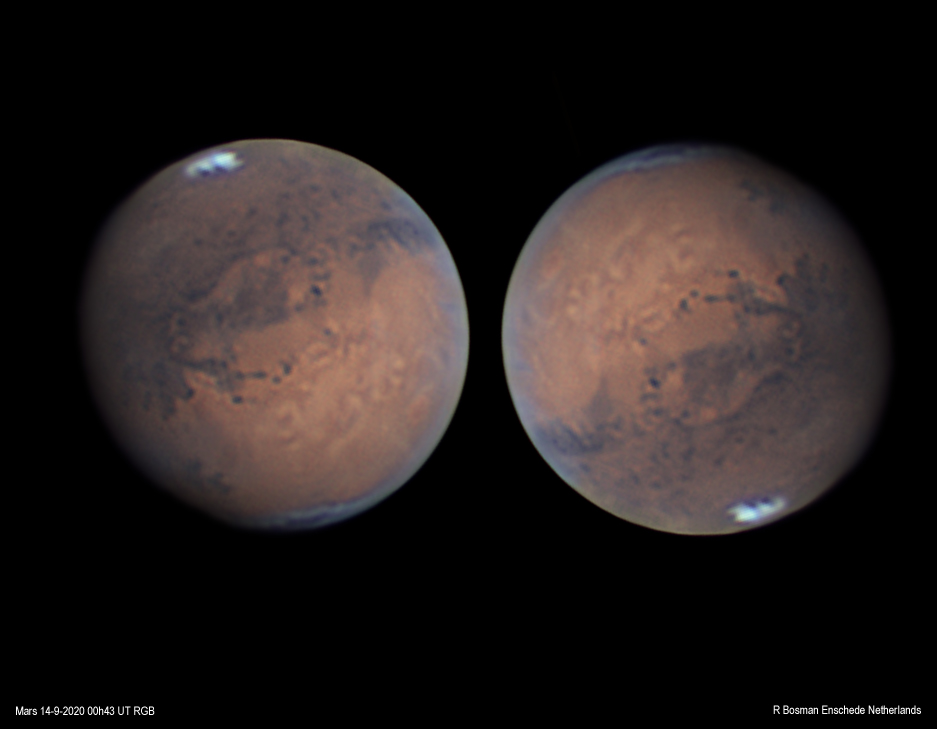 Mars Red Green en Blue images 14-9-2020 00h43
Mars Red Green en Blue images 14-9-2020 00h43
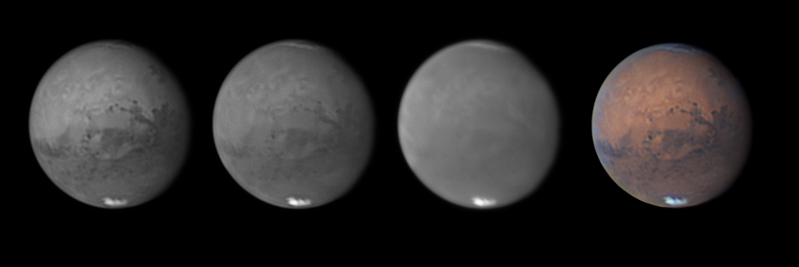 Unauthorized use prohibited
無断使用禁止
[ボスマン:オランダ]
[copyright(c)2006 Richard Bosman: Netherlands]
Unauthorized use prohibited
無断使用禁止
[ボスマン:オランダ]
[copyright(c)2006 Richard Bosman: Netherlands]
At the time of recording,its distance from the Earth - 67 million 329 thousand 522 km Visible angle diameter: 20.81 "Phase: 95.2%. 22.57 "Phase: 99.6%
Binoculars: Celestron NexStar 6 SE SC OTA,Mechanics: SkyWatcher Star Adventurer travel mountt,Camera: ZWO ASI 290MC color CMOS camera
Concealer: Explore Scientific 3x Focus Extender (1.25 "),Exp. Time: 2.5 - 3 msec,gain 270,gamma 45,ROI 304x30
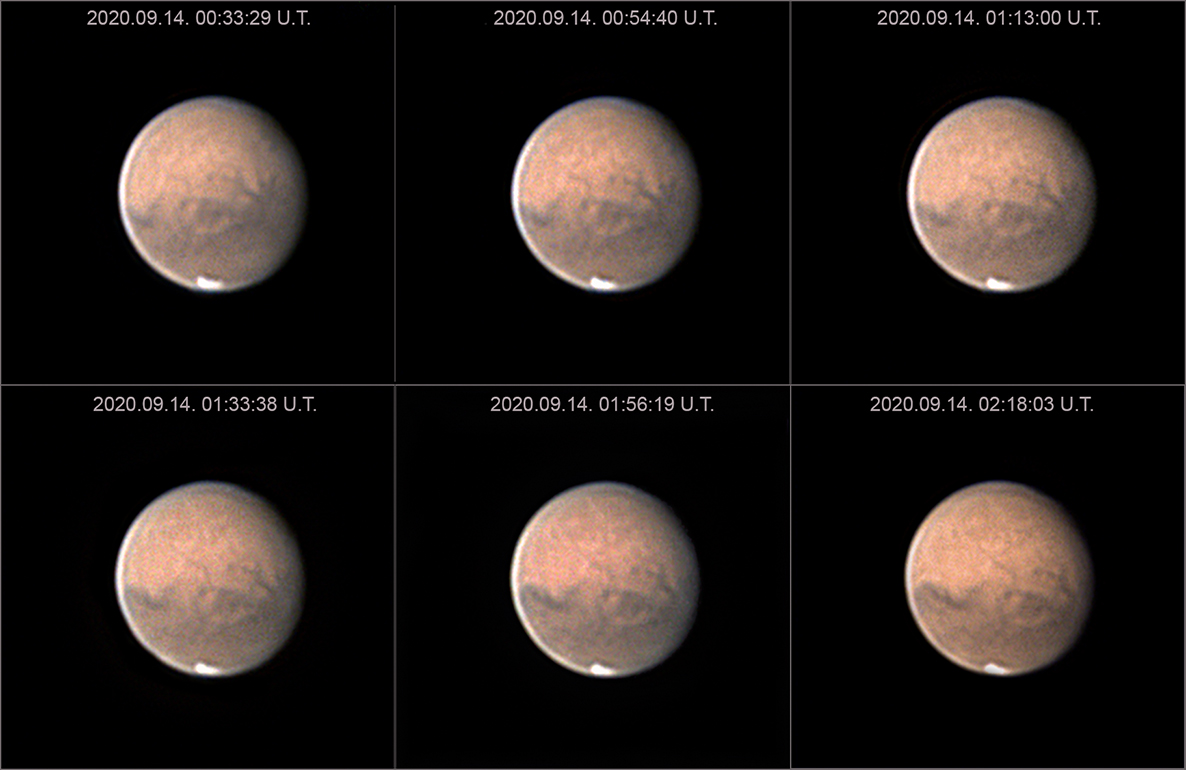 [Marin Prodan : Hungary.]
[Marin Prodan : Hungary.]
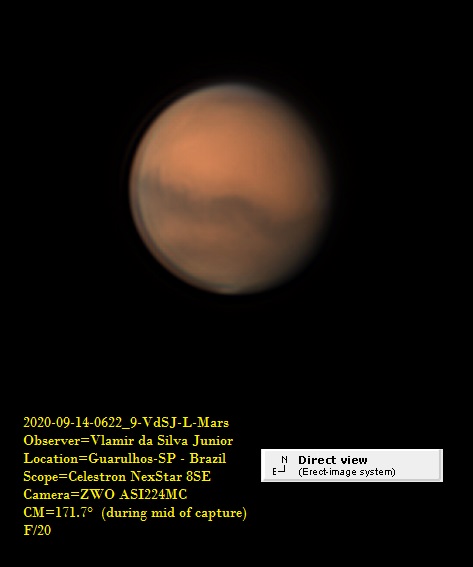 [Vlamir da Silva Junior : Sao Paulo,Brazil]
[Vlamir da Silva Junior : Sao Paulo,Brazil]

 -------------------------------------------------------------------------------------
-------------------------------------------------------------------------------------
 [Moises Portillo Leon,Andujar:Spain)]
[Moises Portillo Leon,Andujar:Spain)] [Clyde Foster:Centurion,South Africa]
[Clyde Foster:Centurion,South Africa] Seeing was AII-III with hazy conditions,but I had some excellent views of the Martian surface at a power of x300 on my 12" Reflector.
The main points of interest were as follows:
- South Polar Cap somewhat irregular but easy to see.
- Argyle I and Argyre II fairly well defined as was Campi Phlegrael.
- Solis Lacus again well presented,Thaumasia and Felix well defined.
- A lot of interesting detail in Mare Erythraeum.
- Ophir was bright a bright streak present in Candor next to Ganges which was appeared as a darker streak.
- Niliacus Lacus present on the prec. limb? Nilokeras also seen.
Seeing was AII-III with hazy conditions,but I had some excellent views of the Martian surface at a power of x300 on my 12" Reflector.
The main points of interest were as follows:
- South Polar Cap somewhat irregular but easy to see.
- Argyle I and Argyre II fairly well defined as was Campi Phlegrael.
- Solis Lacus again well presented,Thaumasia and Felix well defined.
- A lot of interesting detail in Mare Erythraeum.
- Ophir was bright a bright streak present in Candor next to Ganges which was appeared as a darker streak.
- Niliacus Lacus present on the prec. limb? Nilokeras also seen.
 [Paul G. Abel:Leicester:United Kingdom]
[Paul G. Abel:Leicester:United Kingdom]
 [ Randy Tatum,Richmond,VA U.S.A]
[ Randy Tatum,Richmond,VA U.S.A] [Jorge Rallo : Madrid,Spain]
[Jorge Rallo : Madrid,Spain] ≪奈良県奈良市 荒川 毅≫[Tsuyoshi Arakawa:Nara Japan]
≪奈良県奈良市 荒川 毅≫[Tsuyoshi Arakawa:Nara Japan]
 [Pericles Enache,Sao Paulo,Brazil]
[Pericles Enache,Sao Paulo,Brazil] [Walter Martins : SAO PAULO BRAZIL]
[Walter Martins : SAO PAULO BRAZIL] [Chris Nuttall : York,UK]
[Chris Nuttall : York,UK] ≪滋賀県守山市 森田光治≫[Mitsuji Morita:Siga Japan]
≪滋賀県守山市 森田光治≫[Mitsuji Morita:Siga Japan] ≪大阪府 枚方市 井上 修≫[Osamu Inoue. Hirakata-shi,Osaka,Japan]
≪大阪府 枚方市 井上 修≫[Osamu Inoue. Hirakata-shi,Osaka,Japan]
 [Anthony Wesley,Murrumbateman Australia]
≪アンソニ オーストラリア≫
[Anthony Wesley,Murrumbateman Australia]
≪アンソニ オーストラリア≫
 ≪ 大阪府 枚方市 薄出敏彦≫[Toshihiko-Usude: Ohsaka Japan]
≪ 大阪府 枚方市 薄出敏彦≫[Toshihiko-Usude: Ohsaka Japan] [Stanislas Maksymowicz Ecquevilly,France]
[Stanislas Maksymowicz Ecquevilly,France] ≪大分県大分市 中野雄吉≫
[Yuukichi Nakano : Ohita-Ohoita prefecture Japan]
≪大分県大分市 中野雄吉≫
[Yuukichi Nakano : Ohita-Ohoita prefecture Japan] ≪岡山県岡山市 鶴海敏久≫[Toshihisa Tsurumi:Okayama-City Okayama-Prefecture Japan]
≪岡山県岡山市 鶴海敏久≫[Toshihisa Tsurumi:Okayama-City Okayama-Prefecture Japan] ≪大阪府堺市 熊森照明≫[Teruaki Kumamori:Ohsaka Japan]
≪大阪府堺市 熊森照明≫[Teruaki Kumamori:Ohsaka Japan] ≪静岡県浜松市 山口貴弘≫[Takahiro Yamaguchi : Hamamatsu-City Shizuoka-Prefecture Japan]
≪静岡県浜松市 山口貴弘≫[Takahiro Yamaguchi : Hamamatsu-City Shizuoka-Prefecture Japan] [Simon Kidd: Welwyn Herts,United Kingdom]
[Simon Kidd: Welwyn Herts,United Kingdom] [Efrain Morales Rivera Aguadilla:Puerto Rico]
[Efrain Morales Rivera Aguadilla:Puerto Rico] [Siegfried Gonzi : Exeter,United Kingdom]
[Siegfried Gonzi : Exeter,United Kingdom] [Kev Wildgoose:Oswestry,UK]
[Kev Wildgoose:Oswestry,UK]

 --------------------------------------------------------------
≪滋賀県 大津市 安達 誠≫[Makoto Adachi:Siga Japan]
--------------------------------------------------------------
≪滋賀県 大津市 安達 誠≫[Makoto Adachi:Siga Japan] [Sonka Adrian Bruno:Bucharest,Romania]
[Sonka Adrian Bruno:Bucharest,Romania] [スセンバッハ:オランダ]
[John Sussenbach:Houten,Netherlands]
[スセンバッハ:オランダ]
[John Sussenbach:Houten,Netherlands]
 [Willian Souza : Sao Paulo,Brazil]
[Willian Souza : Sao Paulo,Brazil] [Jean-Luc Dauvergne:Paris France]
[Jean-Luc Dauvergne:Paris France] [Kenkichi Yunoki (Sakai City,Japan)]
≪大阪府 堺市 柚木健吉≫
[Kenkichi Yunoki (Sakai City,Japan)]
≪大阪府 堺市 柚木健吉≫ ≪愛知県 春日井市 伊藤了史≫[Satoshi Ito. Kasugai City,Aichi,Japan]
≪愛知県 春日井市 伊藤了史≫[Satoshi Ito. Kasugai City,Aichi,Japan] [Johan Warell:Lindby:Sweden]
[Johan Warell:Lindby:Sweden] [Ki.Ozaki,Sobue Inazawa Aichi JAPAN]
≪愛知県稲沢市祖父江町 尾崎公一≫
[Ki.Ozaki,Sobue Inazawa Aichi JAPAN]
≪愛知県稲沢市祖父江町 尾崎公一≫ [ Christian Pankratz : Berlin Germany]
[ Christian Pankratz : Berlin Germany] Here then the impression of Mars that morning.
Here then the impression of Mars that morning.
 Mars Red Green en Blue images 14-9-2020 00h43
Mars Red Green en Blue images 14-9-2020 00h43
 Unauthorized use prohibited
無断使用禁止
[ボスマン:オランダ]
[copyright(c)2006 Richard Bosman: Netherlands]
Unauthorized use prohibited
無断使用禁止
[ボスマン:オランダ]
[copyright(c)2006 Richard Bosman: Netherlands] [Marin Prodan : Hungary.]
[Marin Prodan : Hungary.] [Vlamir da Silva Junior : Sao Paulo,Brazil]
[Vlamir da Silva Junior : Sao Paulo,Brazil] ALPO-Japan Latest
ALPO-Japan Latest